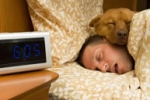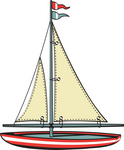Hello, Everyone. First timer poster, but an experienced CPAP user (3 years).
Wow, you folks are awesome! Your insights and experiences are so much
more valuable than the detached responses I always seem to get from my
doctors and nurses.
You all have inspired me to upgrade my machine, probably to an S9 auto, so
I can take more control of my sleep quality. I see that the new machines offer
data collection and an oximetry connection. Almost like my very own sleep study
every night! I also have a Zeo machine, which I am hopeful will provide additional
data to help me with my sleep quality.
As an engineer and problem solver, I find myself wondering if there are specific
pieces of data or metrics that are the real key determinants of a good nights sleep.
I would like to think some academic paper has a NUMERICAL description of a good nights sleep.
If ESPN can go Inside the Numbers and show us quarterback ratings and power rankings and baseball's
Moneyball stats out the wazzoo, surely someone knows how to MODEL a Good Nights Sleep!?
So my question to you thoughtful experts is, what numbers matter the most? I know it cant be just AHI,
or minimum oxygen levels (SaO2). I am scoring well with Zeo metrics, but still running at about 50-75%
of my mental and physcial energy levels. So it can't be just hours of REM sleep, or deep sleep, etc.
For those of you who have been swimming in the data for some time now, is there some combination
of metrics that yield a Good Nights Sleep for you?
Thanks, again, All. JD from Atlanta
Let's go "Inside the Numbers..." for a Good Nights Sleep
- chunkyfrog
- Posts: 34545
- Joined: Mon Jul 12, 2010 5:10 pm
- Location: Nowhere special--this year in particular.
Re: Let's go "Inside the Numbers..." for a Good Nights Sleep
First off, when you are shopping for a new machine, you need to avoid any Resmed machine with the word "Escape" in it.
(but you can use your 'escape' key to freeze any animated icon)
About the data: I write down my hours slept, average pressure, AHI, AI, and which mask I wore that night.
No one number is all-important, but some give more information--with the entire array and trends the most revealing.
Others use the software, printing out bushels of graphs and wave forms--cool, but it depends on what gets your pulse up.
This can give insight to more complex situations--YMMV.
(but you can use your 'escape' key to freeze any animated icon)
About the data: I write down my hours slept, average pressure, AHI, AI, and which mask I wore that night.
No one number is all-important, but some give more information--with the entire array and trends the most revealing.
Others use the software, printing out bushels of graphs and wave forms--cool, but it depends on what gets your pulse up.
This can give insight to more complex situations--YMMV.
_________________
| Mask: AirFit™ P10 For Her Nasal Pillow CPAP Mask with Headgear |
| Additional Comments: Airsense 10 Autoset for Her |
Re: Let's go "Inside the Numbers..." for a Good Nights Sleep
Welcome to you! And may I say, and this isn't an insult, but you sound exactly like an engineer! I am friendly with several of them!
I am planning an appointment with my new Pulmonlogist to have him go over my original sleep studies with me, as well as the Oximetry (sp?) test he personally had done on me. He was aghast when I told him his colleague, whom I first had met, never bothered to it. The poor guy was going to but he had spent so much time with me, the office was closing. So I really in the dark.
I was going over it the other day and thought, I don't really understand anything except I never move in my sleep, which my husband had already told me, and without the mask I was averaging 10 episodes of apnea per hour. That and I never have REM sleep. The rest, I knew, he could explain to me or I could figure out from paying more attention here.
I have arthritis which forces me to take a narcotic for chronic pain and I'm currently in the midst of my first "flare" and I decided Id wait until it's over before I do an serious studying. But I agree. I'm not an engineer but I'm a fixer and always think I can make everything right. There must be a model we could go by.
Welcome!
I am planning an appointment with my new Pulmonlogist to have him go over my original sleep studies with me, as well as the Oximetry (sp?) test he personally had done on me. He was aghast when I told him his colleague, whom I first had met, never bothered to it. The poor guy was going to but he had spent so much time with me, the office was closing. So I really in the dark.
I was going over it the other day and thought, I don't really understand anything except I never move in my sleep, which my husband had already told me, and without the mask I was averaging 10 episodes of apnea per hour. That and I never have REM sleep. The rest, I knew, he could explain to me or I could figure out from paying more attention here.
I have arthritis which forces me to take a narcotic for chronic pain and I'm currently in the midst of my first "flare" and I decided Id wait until it's over before I do an serious studying. But I agree. I'm not an engineer but I'm a fixer and always think I can make everything right. There must be a model we could go by.
Welcome!
_________________
| Mask | ||||
 | ||||
| Additional Comments: My mask was the Wisp until it started making marks on my nose that doctors thought were leading to my skin breaking down. | ||||
Yawning in NH
Re: Let's go "Inside the Numbers..." for a Good Nights Sleep
I look at Leak numbers, if they're too high then all the other data may not be reliable.
_________________
| Mask: Mirage Quattro™ Full Face CPAP Mask with Headgear |
| Additional Comments: 14/8.4,PS=4, UMFF, 02@2L, |
"Do or Do Not-There Is No Try"-"Yoda"
"We are what we repeatedly do,so excellence
is not an act but a habit"-"Aristotle"
DEAR HUBBY BEGAN CPAP 9/2/08
"We are what we repeatedly do,so excellence
is not an act but a habit"-"Aristotle"
DEAR HUBBY BEGAN CPAP 9/2/08
Re: Let's go "Inside the Numbers..." for a Good Nights Sleep
I look more for the number of hours when I slept without an episode of any sort. The raw numbers include events while going to sleep or waking up and skew the numbers. If I see many hours of good sleep, I'm not as concerned about the number of apneas and hypopneas, although I wouldn't want that number to get very high.
- The Sheikh
- Posts: 165
- Joined: Sun Aug 19, 2012 12:22 pm
Re: Let's go "Inside the Numbers..." for a Good Nights Sleep
Hi J,
Being an engineer, I'm sure you appreciate the value of analyzing waveforms and getting a trained eye for what is really happening internally.
When you get your new data-capable machine, study all the breathing charts and start learning what it looks like to be awake, fall asleep, what deep sleep looks like, what a bad apneas looks like ,etc, etc. Then each day expand the flow rate chart and look breath by breath to see what went on the last night.
As you accumulate data you will then start to look at the statistics and find what your own sweet spots are. After awhile you will know what a "normal," good," or "bad" night looks like for you.
Remember that you are optimizing your OWN sleeping and it may be different from other peoples' data, so there are no right or wrong numbers, unless the data is way out of range and causing you problems.
For example, I was just watching a champion triathlete who used Zeo on U-Tube. His light sleep was about three times longer than mine, while my REM was three times longer than his on average. We had about the same deep sleep. He awoke only once all night while I awoke about 3 times. I would imagine his data is "better" than mine, but is it really? We need to find the sweet spots for ourselves and what makes us feel best.
If you really study your SleepyHead chart data, Zeo and O2 levels closely and learn your own personal chart patterns, (and what they mean) you will become you own best coach.
Once you learn to analyze your own data and sleep habits, you can then review it less often and start to go by how well you feel each day. But the background learning is important to start.
Tom (also have engineering background)
Being an engineer, I'm sure you appreciate the value of analyzing waveforms and getting a trained eye for what is really happening internally.
When you get your new data-capable machine, study all the breathing charts and start learning what it looks like to be awake, fall asleep, what deep sleep looks like, what a bad apneas looks like ,etc, etc. Then each day expand the flow rate chart and look breath by breath to see what went on the last night.
As you accumulate data you will then start to look at the statistics and find what your own sweet spots are. After awhile you will know what a "normal," good," or "bad" night looks like for you.
Remember that you are optimizing your OWN sleeping and it may be different from other peoples' data, so there are no right or wrong numbers, unless the data is way out of range and causing you problems.
For example, I was just watching a champion triathlete who used Zeo on U-Tube. His light sleep was about three times longer than mine, while my REM was three times longer than his on average. We had about the same deep sleep. He awoke only once all night while I awoke about 3 times. I would imagine his data is "better" than mine, but is it really? We need to find the sweet spots for ourselves and what makes us feel best.
If you really study your SleepyHead chart data, Zeo and O2 levels closely and learn your own personal chart patterns, (and what they mean) you will become you own best coach.
Once you learn to analyze your own data and sleep habits, you can then review it less often and start to go by how well you feel each day. But the background learning is important to start.
Tom (also have engineering background)
_________________
| Machine: ResMed AirCurve 10 ASV Machine with Heated Humidifier |
| Mask: Apex Wizard 310 Nasal CPAP Mask |
| Humidifier: S9™ Series H5i™ Heated Humidifier with Climate Control |
| Additional Comments: ResMed Adapt SV (ASV), PR AutoSV Advanced ASV, with SleepyHead, CMS-55H Oximeter and ZEO sleep monitor |
Last edited by The Sheikh on Fri Sep 14, 2012 8:51 pm, edited 2 times in total.
Re: Let's go "Inside the Numbers..." for a Good Nights Sleep
If you had severe OSA before CPAP therapy, then three things were definitely occurring:
1. Because of hundreds of micro-awakenings, you spent very little time in Delta-wave sleep (Stage 4). Which is the "restorative phase of sleep".
2. Your SaO2 levels were low enough that you were starving every organ in your body of needed oxygen.
3. Your REM was so fragmented that you probably felt like you were going crazy when awake -- which technically you were.
So -- you'll definitely know if CPAP therapy is giving you quality sleep. You can try to document it and chart it with the sleep data (and I think a periodic check is good idea) but I wouldn't get so fixated on the numbers that it turns you into a worry-wart. Unless of course the data points toward a specific problem with your treatment. Then, by all means pursue it.
In addition to CPAP, I find that good sleep hygiene is imperative for producing a good night's sleep. I'll give you my list:
Start off with the most comfortable mattress set you can afford. SPLURGE -- go get something that is literally heaven to lay on.
Buy some expensive Egyptian Cotton 1500 Thread Count sheets. You won't be sorry.
Keep your room cool enough that you actually want to get under the comforters.
Keep your room pitch dark. If you find that your LED alarm clock is pretty bright with the lights off, cover it up.
Keep air moving in your bedroom -- overhead fans and/or a good floor fan. Also helps to introduce some background fan noise in the room. To me, a totally quiet room is deafening.
1. Because of hundreds of micro-awakenings, you spent very little time in Delta-wave sleep (Stage 4). Which is the "restorative phase of sleep".
2. Your SaO2 levels were low enough that you were starving every organ in your body of needed oxygen.
3. Your REM was so fragmented that you probably felt like you were going crazy when awake -- which technically you were.
So -- you'll definitely know if CPAP therapy is giving you quality sleep. You can try to document it and chart it with the sleep data (and I think a periodic check is good idea) but I wouldn't get so fixated on the numbers that it turns you into a worry-wart. Unless of course the data points toward a specific problem with your treatment. Then, by all means pursue it.
In addition to CPAP, I find that good sleep hygiene is imperative for producing a good night's sleep. I'll give you my list:
Start off with the most comfortable mattress set you can afford. SPLURGE -- go get something that is literally heaven to lay on.
Buy some expensive Egyptian Cotton 1500 Thread Count sheets. You won't be sorry.
Keep your room cool enough that you actually want to get under the comforters.
Keep your room pitch dark. If you find that your LED alarm clock is pretty bright with the lights off, cover it up.
Keep air moving in your bedroom -- overhead fans and/or a good floor fan. Also helps to introduce some background fan noise in the room. To me, a totally quiet room is deafening.
................21+ years of restorative, apnea-free sleep.











